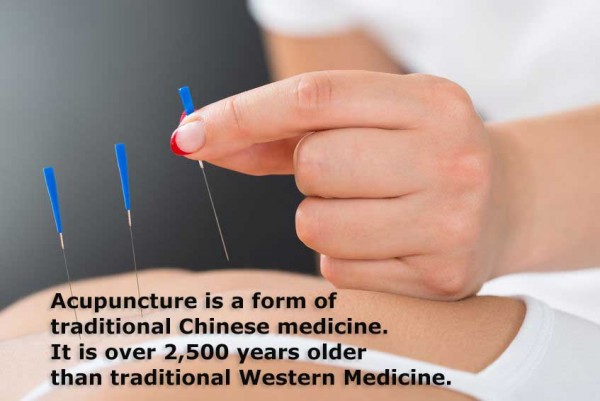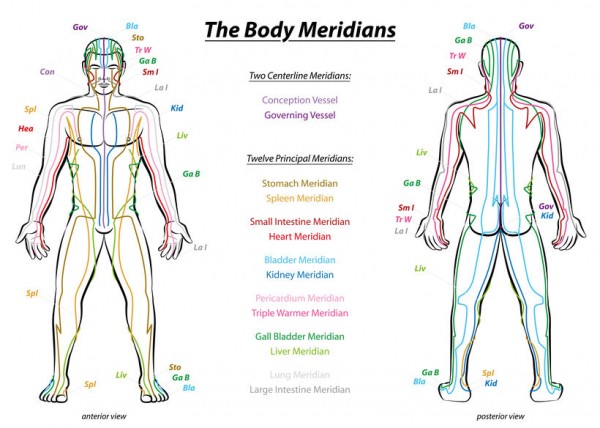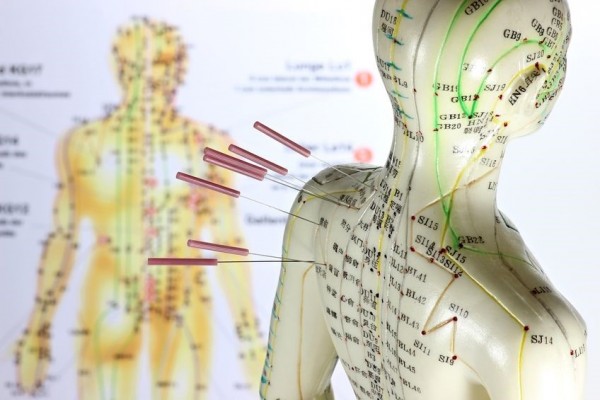
 Acupuncture is a form of traditional Chinese medicine. It is over 2,500 years older than traditional Western Medicine. It works by applying thin needles, heat, and pressure to specific points on the body redirecting the body's natural energy known as chi or qi. This is based on the concept that chronic pain and illness can form blockages and imbalances in the chi or qi, the vital life force.
Acupuncture is a form of traditional Chinese medicine. It is over 2,500 years older than traditional Western Medicine. It works by applying thin needles, heat, and pressure to specific points on the body redirecting the body's natural energy known as chi or qi. This is based on the concept that chronic pain and illness can form blockages and imbalances in the chi or qi, the vital life force.
There is also a form of acupuncture called "needle cupping." Needle cupping is done by some, but not all acupuncturists. With this treatment, cups are placed over an acupuncture needle after it is inserted. It helps with blood circulation in the localized area. Cupping Therapy originates from China, but today is a treatment worldwide, where a practitioner places special cups on a person's skin that creates suction to facilitate healing.
Acupressure is a type of acupuncture that uses light electrical stimulations that flow through needles, but it can also be done with the hands. It differs from acupuncture in being more of a massage-type technique. It works by stimulating energy in the body by pressing on certain points. Acupressure is often administered by a massage therapist with some form of massage therapy done in conjunction. However, you can be trained to do the technique yourself in order to treat conditions such as; vomiting, motion sickness, headaches, neck pain, back pain, chronic fatigue, fibromyalgia, mental and emotional stress, and even addiction or learning disorders. It is done to relieve pain, reduce tension in muscles, improve circulation and cause deep feelings of relaxation.
 Thin, hair-like needles are inserted very shallowly into the skin to intercept or unblock the flow of energy (chi or qi) at specific locations known as “acupoints.” When done by an experienced practitioner it is considered pain-free. Chi is considered the energy life force in your body. An unbalanced Chi means a person is sick, in pain, has poor sleep, or fatigue. The concept of Chi is used in many ancient cultures for medicine and healing including; India, China, Japan, and Native American cultures.
Thin, hair-like needles are inserted very shallowly into the skin to intercept or unblock the flow of energy (chi or qi) at specific locations known as “acupoints.” When done by an experienced practitioner it is considered pain-free. Chi is considered the energy life force in your body. An unbalanced Chi means a person is sick, in pain, has poor sleep, or fatigue. The concept of Chi is used in many ancient cultures for medicine and healing including; India, China, Japan, and Native American cultures.
There are 14 energy-channel meridians on the body, with hundreds of points located along each meridian. (Dr. Axe) These meridians extend across the hands, arms, feet, head, back, and all major organs with 360 different points for inserting needles. These points are mostly located at the midpoint of a muscle, where the muscle joins bone, or where nerves enter a muscle. Some of the major meridians include; Kidney Meridian, Liver Meridian, Heart Meridian, Stomach Meridian, Lung Meridian, Large Intestine, and Small Intestine Meridian.
The View Point of Western Practitioners on How Acupuncture Works
Many Western practitioners don’t believe in the concept of chi and meridians, and instead, describe acupuncture as working through a neurological model. They explain it as acupuncture needles stimulate nerve endings that alter brain function, specifically the intrinsic pain inhibitory mechanisms. In Western scientific terms, it is also thought that acupuncture eases pain by altering hormone levels or the immune system.
Research shows acupuncture helps to relieve and relax knotted muscles. Knots occur in the lower back muscles, shoulders, elbows, and so on. The needles also have an effect on the nerves in local tissues. They stimulate nerve endings in the area which causes the release of chemical substances. These chemicals increase blood flow to the skin which means more nutrients and oxygen coming into the tissues. And, an increase in the removal of waste products. This promotes healing or improves the function of local tissues. (Nikki Hawkes, 2016)
 Acupuncture has been considered helpful with a lot of stress related problems, pain, and a variety of diseases. It has grown in popularity in America as a complementary treatment to help treat; anxiety, gastrointestinal issues, weight loss, infertility, and chronic pain. It has gained a lot of acceptance as an alternative treatment for low back pain, neck pain, shoulder pain, headaches, and osteoarthritis based on several research studies. Acupuncture has been said to produce positive side effects including; better sleep, better digestion, more energy, mental clarity, and less stress. It has also shown positive results in treating pain associated with chemotherapy for cancer patients.
Acupuncture has been considered helpful with a lot of stress related problems, pain, and a variety of diseases. It has grown in popularity in America as a complementary treatment to help treat; anxiety, gastrointestinal issues, weight loss, infertility, and chronic pain. It has gained a lot of acceptance as an alternative treatment for low back pain, neck pain, shoulder pain, headaches, and osteoarthritis based on several research studies. Acupuncture has been said to produce positive side effects including; better sleep, better digestion, more energy, mental clarity, and less stress. It has also shown positive results in treating pain associated with chemotherapy for cancer patients.
Other Conditions Acupuncture Could Help with Include: Allergies, Asthma, Addictions, Carpal Tunnel Syndrome, Depression, Fibromyalgia, Menstrual Cramps, Insomnia, Muscle Spasms, Myofascial Pain, Osteoarthritis, Parkinson’s Disease, and Pregnancy Symptoms.
Acupuncture should not be used as primary treatment for any type of serious illness. It is recommended to try and get a clear diagnosis of what is causing your pain before using acupuncture, in order to rule out any serious medical conditions. Acupuncture is considered relatively safe, as long as you go to a well-trained practitioner with a facility that makes sure to use clean needles. It can be very risky, when not done correctly or performed with contaminated needles.
The FDA does regulate it though. They make sure needles are properly marked for “single-use, nontoxic, and sterile by qualified practitioners only.” The needles are considered medical equipment. There have been very few reports of problems with practitioners. Acupuncture is considered a safer way to treat pain, as opposed to medications which can produce horrible side effects. In rare situations people have had temporary side effects such as; fatigue, soreness, lightheadedness, or muscle twitching.
 Acupuncture is known to originate in China. There is evidence dating back to about 6000 BC of possible instruments used for acupuncture. Documents discovered in the Ma-Wang-Dui tomb in China in 198 BC do not refer to acupuncture, but do show a system of meridians. The first recognizable documentation of Acupuncture where it is described as a diagnosis and treatment is from around 100 BC known as The Yellow Emperor’s Classic of Internal Medicine. Acupuncture developed over the centuries in China. It eventually became a standard therapy next to herbs, massage, diet, and heat. Modern acupuncture is based on the The Great compendium of Acupuncture and Moxibustion written by Wang Weiyi which was published during the Ming Dynasty from 1368 to 1644.
Acupuncture is known to originate in China. There is evidence dating back to about 6000 BC of possible instruments used for acupuncture. Documents discovered in the Ma-Wang-Dui tomb in China in 198 BC do not refer to acupuncture, but do show a system of meridians. The first recognizable documentation of Acupuncture where it is described as a diagnosis and treatment is from around 100 BC known as The Yellow Emperor’s Classic of Internal Medicine. Acupuncture developed over the centuries in China. It eventually became a standard therapy next to herbs, massage, diet, and heat. Modern acupuncture is based on the The Great compendium of Acupuncture and Moxibustion written by Wang Weiyi which was published during the Ming Dynasty from 1368 to 1644.
Interest of acupuncture declined in the seventeenth century, and it was outlawed in 1929 with increasing acceptance of Modern Medicine. However, it was reestablished in the 1950’s in a consensus known as Traditional Chinese Medicine (TCM) that also includes herbal medicine.
Acupuncture became popular in the West in 1971 after the New York Times reporter, James Reston, received unexpected acupuncture treatment while in China. He wrote about it in an article called “Now, About My Operation in Peking.”
An international team of experts did 29 studies on how effectively acupuncture relieves common forms of pain. The study involved around 18,000 participants. The results of the studies combined showed real relief from common pain. Some had acupuncture, some didn’t, and some had “sham” acupuncture. Overall, the results showed acupuncture relieved pain by about 50%. The study is published in the Archives of Internal Medicine.
There have been several studies done showing positive results with Acupuncture treatment for:
- Reducing Headaches and Migraines
- Improving Chronic pain, Including for the Back, Neck, Knee or Arthritis pain
- Help Treating Insomnia
- Improving Cancer and Chemotherapy Recovery
- Helps to Prevent Cognitive Decline (Parkinson’s disease)
- Reduce Stress, Balance Hormones, and Ease Anxiety and Pain of Pregnancy & Labor
 Licensing requirements for acupuncturists are not the same in every state. However, three trade associations founded standards of practice in 1981. The three trade associations are; The Council of Colleges of Acupuncture and Oriental Medicine (CCAOM), The Accreditation Commission for Acupuncture and Oriental Medicine (ACAOM), and the National Certification Commission for Acupuncture and Oriental Medicine (NCCAOM).
Licensing requirements for acupuncturists are not the same in every state. However, three trade associations founded standards of practice in 1981. The three trade associations are; The Council of Colleges of Acupuncture and Oriental Medicine (CCAOM), The Accreditation Commission for Acupuncture and Oriental Medicine (ACAOM), and the National Certification Commission for Acupuncture and Oriental Medicine (NCCAOM).
Most states in the U.S. require the NCCAOM certification. To find a licensed accredited acupuncturist in your area, you can search on NCCAOM or Acufinder. Some insurance companies do cover acupuncture, so take a look to see what practitioners maybe covered under your policy.
The acupuncturist will start out by reviewing your medical history, learning about your pain, and finding out your health-related goals. They will then look at your tongue and press on vital organs to see if they can find the imbalance contributing to the pain. Then, the acupuncturist will insert by hand 10 to 20 thin, hair like needles along meridians of your body. Next, they will check the “pulses” on your body by placing fingers and hands where they can feel the flow of energy. If redness appears around a needle, this could signal an energy imbalance in that area of the body. Needles are left in anywhere from 15 to 45 minutes. The length of time will depend on the technique and desired result. Once the needles are removed you can go about your normal day.
To help the detoxifying process, its advised to drink plenty of water. Treatments maybe weekly starting out, but it all depends on your health condition.
Weil M.D., Andrew. WEIL/Acupressure. Retrieved from: https://www.drweil.com/health-wellness/balanced-living/wellness-therapies/acupressure/
Lagatree, Kirsten M. (2017, July 18th) Practical Pain Management (PPM)/The Role of Acupuncture in Treating Chronic Pain. Retrieved from: https://www.practicalpainmanagement.com/patient/treatments/alternative/role-acupuncture-treating-chronic-pain
Pendick, Daniel. (2013, April 1). Harvard Health Publishing: Harvard Medical School/Acupuncture is Worth a Try for Chronic Pain. Retrieved from: https://www.health.harvard.edu/blog/acupuncture-is-worth-a-try-for-chronic-pain-201304016042
Dr. Axe, Josh. Dr. Axe/What is Acupuncture? 6 Ways It Can Improve Your Health. Retrieved from: https://draxe.com/what-is-acupuncture/
White, Ernst E. (2014, May 1). OXFORD ACADEMIC (RHEUMATOLOGY)/A brief history of acupuncture. Retrieved from: https://academic.oup.com/rheumatology/article/43/5/662/1788282
Suvow L.Ac., Scott. Kootenay Columbia College of Integrative Health Services/History of Acupuncture. Retrieved from: http://kootenaycolumbiacollege.com/articles/history-of-acupuncture/
Palermo, Elizabeth. (2017, June 21) LIVE SCIENCE/What is Acupuncture?. Retrieved from: https://www.livescience.com/29494-acupuncture.html
Hawkes, Nikki. (2016, December 5) Nikki Hawkes – Acupuncutrist and Medical Herbalist/How acupuncture works – from a Western Perspective. Retrieved from: https://www.nikkihawkes.com/how-acupuncture-works/
